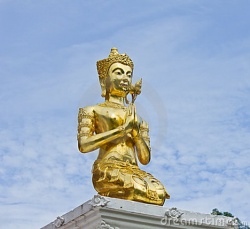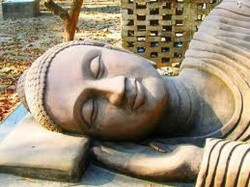Buddha Pronounces the Sūtra of Neither Increase Nor Decrease
Translated from Sanskrit into Chinese in the Northern Wei Dynasty
by
The Tripiṭaka Master Bodhiruci from India
Thus I have heard:
At one time the Buddha was staying on the Gṛdhrakūṭa Mountain, near the city of Rājagṛha, together with 1,250 great bhikṣus and an innumerable, countless multitude of Bodhisattva-Mahāsattvas, in numbers beyond reckoning. In the huge multitude, Śāriputra the Wise rose from his seat, came to the Buddha, and bowed down at His feet. He then stepped back to sit on one side. Joining his palms, he said to the Buddha, “World-Honored One, since time without a beginning, sentient beings have been transmigrating, through the four modes of birth, to and fro along the six life-paths in the Three Realms of Existence, suffering endlessly in saṁsāra. World-Honored One, is this mass of sentient beings, or ocean of sentient beings, increasing or decreasing? I am unable to understand this profound meaning. How should I answer if someone asks me about this?”
The World-Honored One told Śāriputra, “Very good! Very good! You are able to ask me about this profound meaning because you want to give peace to all sentient beings, to give happiness to all sentient beings, to sympathize with all sentient beings, to help all sentient beings, and to give comfort and benefits to all sentient beings, such as gods and humans. Śāriputra, if you did not ask the Tathāgata, the Samyak-Saṁbuddha, about this meaning, there would be many faults. Then, in present and future times, gods, humans, and all other sentient beings would long undergo distress and harm, and lose forever [the opportunity for] all benefits, peace, and joy.
“Śāriputra, the enormously wrong view refers to seeing increase or seeing decrease in the realm of sentient beings. Sentient beings that hold this enormously wrong view are born without eyes and walk the evil way in the long night. For this reason, they go down the evil life-paths in their current lives. Śāriputra, the enormous perilous tribulation refers to one’s obstinate adherence to the wrong view of increase or decrease in the realm of sentient beings. Śāriputra, those who are obstinate in their wrong adherence willfully walk the evil way in the long night. For this reason, they will go down the evil life-paths in their future lives.
“Śāriputra, foolish ordinary beings do not see the one dharma realm in accord with true reality. Because they do not see the one dharma realm in accord with true reality, they elicit the wrong views in their minds, saying that the realm of sentient beings increases or that the realm of sentient beings decreases. Śāriputra, when the Tathāgata is in the world, my disciples will not take these wrong views. However, over five hundred years after my parinirvāṇa, there will be many sentient beings that are foolish and senseless. Although they will remove their hair and beard, donning the three Dharma robes to appear as a śramaṇa in the Buddha Dharma, they will not have within themselves the virtuous ways of a śramaṇa. Such people are not śramaṇas, but they will claim to be śramaṇas. They are not the disciples of the Buddha though they claim to be, saying, ‘I am a śramaṇa, a true disciple of the Buddha.’
“Such people hold the wrong view of increase or decrease. Why? Because these sentient beings follow the Tathāgata’s sūtras of provisional meaning. They do not have the wisdom-eye and are far from the view of emptiness, which accords with true reality. They do not know, in accord with true reality, what the Tathāgata has realized since His initial resolve [to attain Buddhahood); they do not know how to train in and learn, in accord with true reality, the innumerable virtuous ways to realize bodhi; they do not know, in accord with true reality, the innumerable dharmas acquired by the Tathāgata; they do not know, in accord with true reality, the Tathāgata’s immeasurable power; they do not know the Tathāgata’s immeasurable realm; they do not believe in the Tathāgata’s immeasurable action range; they do not know, in accord with true reality, the Tathāgata’s inconceivable command of innumerable dharmas; they do not know, in accord with true reality, the Tathāgata’s innumerable, inconceivable skillful means; they are unable to differentiate the Tathāgata’s immeasurable distinct states; they are incapable of entering into the Tathāgata’s inconceivable great compassion; and they do not know, in accord with true reality, the Tathāgata’s mahāparinirvāṇa.
“Śāriputra, foolish ordinary beings, because they do not have the wisdom developed from hearing the Dharma, uphold the wrong view of cessation or extinction with respect to the nirvāṇa of a Tathāgata. Because of their perception of cessation or extinction, they claim that the realm of sentient beings does decrease. This is an enormously wrong view and an extremely grave, evil karma.
“Furthermore, Śāriputra, from the wrong view of decrease, these sentient beings elicit three more wrong views. These three views and the view of decrease, never separated from one another, are like a web. What are these three wrong views? The first is the view of cessation, which means the ultimate end. The second is the view of extinction, which is equated to nirvāṇa. The third is the view of void nirvāṇa, which means that nirvāṇa is ultimately nothingness. Śāriputra, so fettering, so gripping, and so contagious are these three wrong views!
“Conditioned upon the force of these three wrong views, successively arise two more wrong views. These two views and those three, never separated from one another, are like a web. What are these two wrong views? One is the view of no motivation, and the other is the view that ultimately there is no nirvāṇa. Derived from the wrong view of no motivation are two more wrong views. These two views and the view of no motivation, never separated from one another, are like a web. What are these two wrong views? One is the view that observing useless precepts will lead to a better rebirth, and the other is the inversion view, such as taking impurity as purity.
“Śāriputra, from the wrong view that ultimately there is no nirvāṇa, six more wrong views arise. These six views and the view of no nirvāṇa, never separated from one another, are like a web. What are these six wrong views? The first is that the world has a beginning; the second is that the world has an end; the third is that sentient beings are created by an illusion; the fourth is that there is no suffering or happiness; the fifth is that there is no such thing as (transmigration of] sentient beings; and the sixth is that there is no holy truth.
“Furthermore, Śāriputra, from the wrong view of increase, these sentient beings elicit two more wrong views. These two views and the view of increase, never separated from one another, are like a web. What are these two wrong views? One is the view that nirvāṇa has birth, and the other is the view that nirvāṇa suddenly comes about without causes or conditions. Śāriputra, these two wrong views cause the minds of sentient beings to have no wish and no drive to progress energetically in good dharmas. Śāriputra, even if seven Buddha-Tathāgatas, the Samyak-Saṁbuddhas, successively appeared in the world to pronounce the Dharma to sentient beings that hold these two wrong views, it would be impossible for them to develop any drive to make energetic progress in good dharmas.
“Śāriputra, these two wrong views are the roots of afflictions arising from ignorance. So wrong are the views that nirvāṇa is formed and the view that it suddenly comes about without causes and conditions!
“Śāriputra, these two wrong views are the dharma of extremely evil, enormous fundamental troubles. Śāriputra, from these two wrong views arise all other wrong views. All other wrong views and these two wrong views, never separated from one another, are like a web. All other wrong views include various kinds of views, such as the view of increase and the view of decrease, whether internal or external, whether coarse, fine, or in between.
“Śāriputra, these two wrong views, however, depend on the one realm, share the one realm, and are included in the one realm. Foolish ordinary beings, because they neither know nor see the one realm in accord with true reality, invoke extremely evil views in their minds, saying that the realm of sentient beings increases or that the realm of sentient beings decreases.”
Śāriputra the Wise asked the Buddha, “World-Honored One, what is meant by the one realm? Foolish ordinary beings, because they neither know nor see the one realm in accord with true reality, invoke the extremely evil, enormous wrong views in their minds, saying that the realm of sentient beings increases or that the realm of sentient beings decreases. Very good! World-Honored One, this meaning is too profound for me to understand. I pray only that the Tathāgata will explain to me, to make me understand.”
The World-Honored One told Śāriputra the Wise, “This profound meaning is in the realm of Tathāgata wisdom. It is also in the action range of the TTathāgata’s mind. Śāriputra, all voice-hearers and Pratyekabuddhas with their wisdom are unable to know, to see, or to observe such profound meaning. Much less can all foolish ordinary beings speculate [about it]. Only Buddha-Tathāgatas with their wisdom are able to observe, to know, and to see this meaning. Śāriputra, all voice-hearers and Pratyekabuddhas with all their wisdom can only believe this meaning out of respect, but they are unable to know, to see, or to observe it in accord with true reality. Śāriputra, this profound meaning is in effect the highest truth, and the highest truth is in effect the realm of sentient beings. The realm of sentient beings is in effect the Tathāgata store, and the Tathāgata store is in effect the dharma body. Śāriputra, the dharma body, as I have explained in the inconceivable Buddha Dharma, is not apart, not removed, not severed, and not different from the merit and wisdom of the Tathāgata, which are more abundant than the sands of the Ganges.
“Śāriputra, taking the ordinary lamp as an analogy, its flame and its brightness are not apart or removed from each other. As another analogy, the form and the luster of a precious jewel are not apart or removed from each other. Likewise is the dharma body, as explained by the Tathāgata in the inconceivable Buddha Dharma. It is not apart, not removed, not severed, and not different from the merit and wisdom of the Tathāgata, which are more abundant than the sands of the Ganges.
“Śāriputra, the dharma body is the dharma of no birth and no death, neither of the past nor of the future, because it is beyond the two opposites. Śāriputra, it is not of the past because it is apart from birth; it is not of the future because it is apart from death. Śāriputra, the dharma body of the Tathāgata is eternal because it is the changeless dharma and the endless dharma. Śāriputra, the dharma body of the Tathāgata is eternal because it is the everlasting refuge and it is equal [in all sentient beings) into the endless future. Śāriputra, the dharma body of the Tathāgata is cool because it is the dharma of non-duality and the dharma of no differentiation. Śāriputra, the dharma body of the Tathāgata never changes because it is the dharma of no formation and no destruction.
“Śāriputra, this dharma body, fettered by endless afflictions more numerous than the sands of the Ganges, has been following along with the world since time without a beginning. When it is drifting to and fro in the ocean waves of birth and death, it is called a sentient being. Śāriputra, when this dharma body, tired of the suffering of repeated birth and death in the world, abandons all desires and quests, practices the six pāramitās and goes through the 84,000 Dharma Doors to train in the Bodhi Way, it is then called a Bodhisattva.
“Furthermore, Śāriputra, it is also this dharma body that, having transcended all suffering in the world and having left behind the bondage of afflictions, will reveal its purity and silence, and will abide in pure dharmas on the opposite shore, arriving on the ground that all sentient beings wish for. One who has achieved the unexcelled, ultimate insight into the realm of dharmas, free from all hindrances and obstructions, and has acquired the power of command in the midst of all dharmas, is called a Tathāgata, the Samyak-Saṁbuddha. Therefore, Śāriputra, not apart from the realm of sentient beings is the dharma body; not apart from the dharma body is the realm of sentient beings. The realm of sentient beings is in effect the dharma body; the dharma body is in effect the realm of sentient beings. Śāriputra, these two dharmas under different names have the same meaning.
“Furthermore, Śāriputra, as I said before, there are three kinds of dharmas in the realm of sentient beings. They all are true suchness, without any distinction or difference. What are these three dharmas? The first is the responsive original body of the Tathāgata store, together with pure dharmas. The second is the unresponsive original body of the Tathāgata store, together with fettering afflictions and impure dharmas. The third is the Tathāgata store, equal and eternal in all dharmas.
“Śāriputra, know that the responsive original body of the Tathāgata store, together with pure dharmas, accords with true reality. It is not false, and is not apart or removed from the inconceivable dharma realm of true suchness and pure wisdom. Since the origin without a beginning, there has always been this dharma body responsive to purity. Śāriputra, pertaining to this pure dharma realm of true suchness, I pronounce to sentient beings this inconceivable dharma, called the inherent pure mind.
“Śāriputra, know that the unresponsive original body of the Tathāgata store, together with fettering afflictions and impure dharmas, since the origin without a beginning, has always been apart from and unresponsive to fettering afflictions and impure dharmas which, however, can be eradicated only by one’s bodhi wisdom. Śāriputra, pertaining to this inconceivable dharma realm unresponsive to but fettered by afflictions, I pronounce to sentient beings the inconceivable dharma of the inherent pure mind, though that mind is covered up by afflictions, like dust particles that have become long-term visitors.
“Śāriputra, know that the Tathāgata store, equal and eternal in all dharmas, is the root of all dharmas, complete and replete with all dharmas, and is not apart or removed from the true reality of all worldly dharmas. It underlies all dharmas and encompasses all dharmas. Śāriputra, pertaining to this refuge of the inconceivable pure dharma realm, with neither birth nor death, always cool and never changing, I pronounce that it is called sentient beings. Why? Because sentient beings are in effect the refuge that, with neither birth nor death, is permanent, eternal, cool, and changeless. It is a different name for the inconceivable pure dharma realm. According to this meaning, the pure dharma realm is called sentient beings.
“Śāriputra, all of these three dharmas are true suchness, not distinct, not different. From this neither varying nor changing dharma of true suchness, one never elicits the two extremely evil, wrong views. Why? Because one sees dharmas in accord with true reality. As for the view of increase and the view of decrease, Śāriputra, Buddha-Tathāgatas forever stay far away from these two wrong views. Both views are denounced by Buddha-Tathāgatas.
“Śāriputra, if, among bhikṣus, bhikṣuṇīs, upāsakas, and upāsikās, there are those who hold either or both of these two wrong views, Buddha-Tathāgatas will not be their World-Honored Ones. They are not my disciples. Śāriputra, by holding these two wrong views, these people will go from gloom into gloom, from dark into dark. I say that they are called icchantikas. Therefore, Śāriputra, you all should learn this Dharma to transform sentient beings, enabling them to keep away from these two wrong views and to stay on the right path. Śāriputra, you too should learn this Dharma to keep away from those two wrong views and to stay on the right path.”
After the Buddha pronounced this sūtra, Śāriputra the Wise, bhikṣus, bhikṣuṇīs, upāsakas, and upāsikās, as well as Bodhisattva-Mahāsattvas and the eight classes of Dharma protectors—gods, dragons, yakṣas, gandharvas, asuras, garuḍas, kiṁnaras, and mahoragas—together with humans, nonhumans, and others, greatly rejoiced. They all believed in and reverently carried out the teachings.
—Buddha Pronounces the Sūtra of neither Increase nor Decrease
Translated from the digital Chinese Canon (T16n0668)




